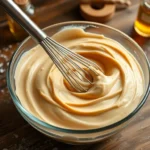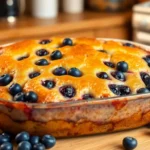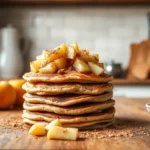These chewy molasses cookies deliver everything we love about old-fashioned baking – deep molasses flavor, warm spices, and that perfect tender-chewy texture that keeps us reaching for just one more. Unlike their crispy counterparts, these cookies stay delightfully soft with slightly crackled tops that hint at the rich sweetness waiting inside.
We’ve perfected this recipe to capture the essence of traditional molasses cookies while ensuring they maintain that coveted chewy texture. The secret lies in the perfect balance of molasses, brown sugar, and just the right amount of flour. Each bite delivers notes of ginger, cinnamon, and cloves that transport you straight to grandmother’s kitchen.
Ingredients
We’ve carefully selected each ingredient to create the perfect balance of flavor and texture in our chewy molasses cookies. These pantry staples work together to deliver that signature deep molasses taste and tender bite you’re craving.
For the Cookie Dough:
- 2¼ cups all-purpose flour
- 1 teaspoon baking soda
- 1 teaspoon ground ginger
- 1 teaspoon ground cinnamon
- ½ teaspoon ground cloves
- ½ teaspoon salt
- ¾ cup unsalted butter, softened
- 1 cup packed dark brown sugar
- ¼ cup granulated sugar
- 1 large egg, room temperature
- ⅓ cup molasses (not blackstrap)
- 1 tablespoon vanilla extract
For Rolling:
- ¼ cup granulated sugar
Our recipe relies on molasses as the star ingredient, providing that distinctive robust flavor and contributing to the cookies’ chewy texture. Dark brown sugar adds moisture and depth while the combination of warm spices creates that nostalgic bakery aroma. We use softened butter rather than melted to ensure our cookies maintain their shape while staying wonderfully tender. The flour ratio creates the perfect structure without making the cookies tough or dry.
Equipment Needed

Creating these perfectly chewy molasses cookies requires the right tools to achieve that tender texture we’re aiming for. We recommend gathering your equipment before starting to ensure a smooth baking process.
Stand Mixer makes the job significantly easier when creaming butter and sugar together. The KitchenAid 5-Qt. Tilt-Head Stand Mixer works exceptionally well for mixing this dough efficiently, though you can certainly make these cookies without one.
Large Mixing Bowls are essential for this recipe. We need one bowl for combining our wet ingredients and another for whisking together the dry spice mixture. Having separate bowls prevents overmixing and ensures even distribution of ingredients.
Whisk or Spatula becomes your best friend if you’re mixing by hand instead of using a stand mixer. These tools help cream the butter and sugar properly, which is crucial for achieving the right cookie texture.
Dough Whisk proves particularly helpful when working with heavier cookie dough like this molasses mixture. This specialized tool cuts through thick dough more effectively than a regular whisk.
Parchment Paper prevents our cookies from sticking to the baking sheet and makes cleanup effortless. We always line our baking sheets with parchment for the best results.
Cookie Scoop ensures every cookie bakes evenly by creating uniform portions. Consistent sizing means all cookies will finish baking at the same time, preventing some from becoming overdone while others remain underbaked.
Baking Sheets should be either non-stick or lightly greased to prevent sticking. We recommend having at least two sheets so you can prepare the next batch while one is in the oven.
Wire Rack allows proper air circulation around cooling cookies, preventing them from becoming soggy on the bottom. Proper cooling maintains that perfect chewy texture we worked so hard to achieve.
Instructions

We’ll guide you through each step to create perfectly chewy molasses cookies with that irresistible tender texture. Follow these detailed instructions to achieve cookies with slightly crackled tops and rich molasses flavor.
Prep the Dry Ingredients
Start by whisking together 2 ¼ cups all-purpose flour, 2 teaspoons baking soda, 1 teaspoon ground cinnamon, ½ teaspoon ground cloves, and ½ teaspoon powdered ginger in a large bowl. Add a pinch of salt if desired to enhance the warm spice flavors. Mix these dry ingredients thoroughly until evenly distributed, ensuring no clumps remain. This careful blending creates the foundation for our cookies’ perfect texture and prevents uneven spice distribution throughout the dough.
Cream Butter and Sugars
Use your stand mixer or a large bowl to cream ¾ cup melted or softened unsalted butter with 1 cup white sugar until the mixture becomes light and fluffy. Beat the mixture for 2-3 minutes at medium speed to incorporate air and create the ideal base for chewy cookies. Pour in ⅓ cup dark molasses and continue mixing until the molasses fully combines with the butter-sugar mixture. The molasses will darken the mixture and create that signature rich flavor we’re seeking.
Add Wet Ingredients
Beat in 1 egg until completely incorporated into the molasses mixture. Add vanilla extract if using, though this ingredient remains optional in our recipe. Continue beating until the wet ingredients form a smooth, cohesive mixture without any streaks of egg visible. This step ensures even distribution of moisture throughout our cookie dough.
Combine Wet and Dry Ingredients
Gradually add the prepared dry ingredient mixture to the wet ingredients, mixing on low speed to prevent flour from flying everywhere. Add the flour mixture in three separate additions, allowing each portion to incorporate before adding the next. Mix just until a cohesive dough forms and no dry flour pockets remain visible. Avoid overmixing at this stage to maintain our cookies’ tender texture.
Chill the Dough
Cover the finished dough with plastic wrap or transfer it to an airtight container. Refrigerate the dough for at least 1 hour, though we can chill it for up to 2-3 days for enhanced flavor development. Chilling firms up the dough and makes it easier to handle while preventing excessive spreading during baking. Cold dough also helps create those desirable slightly cracked tops that signal perfectly baked molasses cookies.
Directions for Baking

Now that our dough has chilled and developed its flavors, we’re ready to transform these molasses-infused portions into perfectly chewy cookies. These final baking steps will create the signature cracked tops and tender texture that make these cookies irresistible.
Preheat and Prepare Baking Sheets
We begin by setting our oven to 350°F (175°C) to ensure even baking throughout. Position the racks in the center of the oven for optimal heat circulation around our cookies.
Line our baking sheets with parchment paper to prevent sticking and make cleanup effortless. The parchment paper also helps distribute heat evenly across the bottom of each cookie.
Shape and Roll the Cookies
Using our cookie scoop, we portion the chilled dough into balls containing 1 to 2 tablespoons each. This consistent sizing ensures uniform baking times and perfectly shaped cookies.
Roll each dough ball thoroughly in granulated sugar until completely coated. The sugar coating creates a delightful crunchy exterior that contrasts beautifully with the chewy interior texture.
Space the sugar-coated balls approximately 2 inches apart on our prepared baking sheets. This spacing allows room for the cookies to spread naturally during baking.
Bake the Cookies
We bake our molasses cookies for 10 to 12 minutes, watching for the telltale signs of doneness. The cookies should spread slightly and develop characteristic cracks across their surface.
Avoid overbaking to maintain the signature chewy texture we’re after. The edges should appear slightly firm while the centers remain soft and tender.
Allow the cookies to cool on the baking sheet for 5 to 10 minutes before transferring. This resting period lets them set properly without breaking apart.
Transfer the cookies to a wire rack to cool completely. The cooling process allows the texture to fully develop into that perfect chewy consistency we desire.
Cooling and Storage

Proper cooling and storage ensure our chewy molasses cookies maintain their perfect texture and rich flavor. Following these steps will keep our cookies fresh and delicious for days to come.
Cooling Instructions
After baking our cookies need immediate attention on the baking sheet for 5 to 10 minutes. This brief cooling period helps the cookies retain their shape while developing that coveted chewy center texture.
We should avoid handling the cookies during this initial cooling phase since they remain delicate and prone to breaking. Once the cookies have set properly we can transfer them to a wire rack for complete cooling.
Complete cooling on a wire rack prevents unwanted soggy bottoms and ensures our cookies maintain their ideal texture. This final cooling step is essential before we move to storage.
Storage Tips
| Storage Method | Duration | Container Type |
|---|---|---|
| Room Temperature | 4-5 days | Airtight container |
| Refrigeration | 5-7 days | Airtight container |
| Freezing | Up to 3 months | Airtight container or bag |
For short term storage we keep our cookies in an airtight container at room temperature where they stay fresh for 4 to 5 days. This method works perfectly for cookies we plan to enjoy within the week.
Refrigeration extends our storage time to 5 to 7 days when we place the cookies in airtight containers. The cooler temperature helps preserve the cookies without compromising their chewy texture.
Long term storage requires freezing our cookies in airtight containers or bags for up to 3 months. We thaw frozen cookies at room temperature or in the refrigerator before serving to restore their original texture.
Maintaining airtight seals on all storage containers prevents moisture from affecting our cookies’ texture and freshness. Proper sealing keeps our molasses cookies tasting just as delicious as the day we baked them.
Make-Ahead Instructions

We can prepare molasses cookie dough well in advance to make our baking schedule more flexible and convenient. The thick dough actually benefits from chilling time which enhances both flavor development and texture control.
Preparing Dough in Advance
After mixing all our ingredients together we should cover the completed dough and refrigerate it for at least 1 hour before baking. The dough stays fresh in the refrigerator for up to 2 to 3 days when properly covered. This extended chilling time allows the spices to meld together while the flour fully hydrates for better texture.
Long-Term Storage Options
For longer storage periods we recommend dividing the dough into workable portions and flattening each into disc shapes. Each disc should be wrapped tightly in plastic wrap to prevent air exposure and moisture loss. These wrapped portions can be refrigerated for several days or frozen for extended storage up to 3 months.
| Storage Method | Time Frame | Temperature |
|---|---|---|
| Refrigerated dough | 2-3 days | 35-40°F |
| Frozen dough discs | Up to 3 months | 0°F |
| Baked cookies (room temp) | Up to 3 days | Room temperature |
Preparing for Baking
When we’re ready to bake we should allow frozen dough to soften slightly at room temperature for easier scooping and shaping. The dough should remain cold enough to hold its shape but pliable enough to work with comfortably.
We use a cookie scoop to portion the chilled dough into uniform balls. Each portion gets rolled between our palms and coated in granulated sugar before being placed on our lined baking sheets. The sugar coating creates that signature sparkly exterior we love on molasses cookies.
Baking and Final Storage
Our prepared cookies bake at 350°F following the same timing guidelines regardless of whether we used fresh or make-ahead dough. Once baked and completely cooled the finished cookies freeze exceptionally well for future enjoyment. We store them in airtight containers at room temperature where they maintain their chewy texture for up to 3 days.
Tips for Perfect Chewy Molasses Cookies

Achieving that perfect chewy texture requires attention to several key details throughout the baking process. We recommend chilling your dough for at least 1 to 2 hours before baking to help retain moisture and maintain the cookie structure. This crucial step prevents excessive spreading and ensures our cookies hold their shape while developing those characteristic cracked tops.
Temperature control plays a vital role in creating the ideal texture. Baking at 350°F (175°C) for 9 to 12 minutes gives us the perfect balance between a set exterior and soft center. We always watch for cookies that appear slightly underbaked in the center since they continue cooking on the hot baking sheet after removal from the oven.
The cooling process directly impacts our final texture. Allowing cookies to rest on the baking sheet for 5 to 10 minutes before transferring helps retain moisture and prevents breaking. This technique locks in that coveted chewy consistency we’re aiming for.
Rolling cookie dough balls in granulated sugar before baking creates a delightful contrast. The sugar coating forms a slightly crispy exterior while the interior remains tender and chewy. We use about 1/4 cup of granulated sugar in a shallow bowl for easy rolling.
Proper dough consistency ensures optimal results. We avoid overmixing once flour gets incorporated to prevent tough cookies. The dough should feel slightly sticky but manageable when properly prepared. Adding flour gradually until just combined maintains the tender crumb structure.
Storage methods preserve our cookies’ chewy texture for days. Airtight containers at room temperature keep cookies fresh for up to 4 days. We place a slice of bread in the container to maintain moisture levels and prevent cookies from hardening.
Troubleshooting Common Issues

Even experienced bakers encounter challenges when making chewy molasses cookies. We’ve compiled the most common problems and their answers to help you achieve perfect results every time.
Dry Cookies
Dry cookies typically result from overbaking or insufficient moisture in the dough. We recommend reducing your baking time by 1 to 2 minutes if you notice this issue. Also, adding water to the dough in small increments can restore the proper moisture balance. Check your oven temperature with a thermometer since some ovens run hot and may be causing premature drying.
Too Soft Cookies
Cookies that lack structure often indicate underbaking or excessive butter content. Increase your baking time by 1 to 2 minutes to achieve the proper set. If the problem persists, reduce the butter quantity slightly in your next batch. The cookies should hold their shape when gently pressed but still feel tender.
Lack of Chewiness
Missing that signature chewy texture usually stems from insufficient molasses or brown sugar content. Both ingredients contribute essential moisture that creates the desired consistency. We suggest increasing the molasses quantity or using only brown sugar instead of a combination with granulated sugar. Brown sugar contains more moisture than granulated sugar, which helps maintain that coveted chewy bite.
Overpowering Molasses Flavor
Strong molasses flavor can overwhelm the delicate spice balance in your cookies. Reduce the molasses amount gradually until you achieve the right flavor profile. Start by decreasing it by one tablespoon and adjust from there. Remember that molasses intensity varies between brands, so you may need to experiment with different types.
Insufficient Spices
Weak spice flavor often results from using old seasonings or inadequate quantities. Replace your ground ginger, cinnamon, and cloves if they’ve been stored for more than a year. Fresh spices deliver the aromatic punch that makes molasses cookies memorable. We recommend tasting your spice blend before adding it to ensure adequate flavor strength.
| Issue | Primary Cause | Solution |
|---|---|---|
| Dry Cookies | Overbaking or insufficient moisture | Reduce baking time by 1-2 minutes; add water incrementally |
| Too Soft Cookies | Underbaking or excess butter | Increase baking time by 1-2 minutes; reduce butter quantity |
| Lack of Chewiness | Insufficient molasses or brown sugar | Increase molasses; use only brown sugar |
| Overpowering Flavor | Too much molasses | Reduce molasses by 1 tablespoon increments |
| Weak Spices | Old or insufficient spices | Replace with fresh ginger, cinnamon, and cloves |
Additional Tips for Perfect Results
Using melted butter instead of softened butter enhances the chewy texture we’re aiming for. Adding an extra egg yolk provides additional moisture and richness to the dough. Avoid overmixing once you combine the wet and dry ingredients, as this can create tough cookies rather than tender ones.
Rolling your cookie dough balls in granulated sugar before baking creates a delightful sweet crunch that contrasts beautifully with the soft interior. This technique also helps achieve those characteristic cracked tops that indicate perfectly baked molasses cookies.
Variations and Substitutions

We love how adaptable chewy molasses cookies can be while maintaining their signature texture and rich spiced flavor. These modifications allow you to customize the recipe based on dietary needs, ingredient availability, or personal preferences.
Sweetener Options
Dark brown sugar serves as our standard base, but we can interchange light brown sugar with minimal impact on the final result. Light brown sugar creates a slightly milder molasses flavor while maintaining the same chewy texture. Maple syrup works as a partial substitute for molasses, replacing up to half the amount for a gentler sweetness profile. Keep in mind that this substitution may reduce the overall chewiness and alter the cookie’s moisture content slightly.
Fat Alternatives
Unsalted butter remains our preferred choice for optimal flavor and texture. Coconut oil provides an excellent plant-based alternative that yields cookies with comparable chewiness, though the flavor profile shifts subtly. We recommend using solid coconut oil at room temperature for the best creaming results with the sugars.
Egg Substitutions
Most traditional recipes rely on one egg for structure and binding. Flax eggs created from ground flaxseed and water offer a suitable vegan replacement, though they may produce cookies with slightly less chewiness than the original. Commercial egg replacers also work effectively, following the manufacturer’s conversion guidelines for one egg equivalent.
Flour Modifications
All-purpose flour delivers the ideal texture we associate with classic molasses cookies. Whole wheat flour can replace up to half the all-purpose flour for added nutritional value and a nuttier flavor profile. Gluten-free all-purpose flour blends work well as direct substitutions, though we may need to adjust liquid ingredients slightly and reduce mixing time to prevent toughness.
Spice Variations
Ground ginger and cinnamon form the essential spice foundation, but we can enhance complexity with additional seasonings. Nutmeg adds warmth and depth when used sparingly, while cardamom contributes a unique floral note. Chopped crystallized ginger folded into the dough creates bursts of intense ginger flavor and delightful textural contrast.
| Spice | Standard Amount | Variation Options |
|---|---|---|
| Ground Ginger | 1 teaspoon | Up to 1½ teaspoons for stronger flavor |
| Cinnamon | 1 teaspoon | Combine with ½ teaspoon nutmeg |
| Cardamom | – | Add ¼ teaspoon for floral notes |
| Crystallized Ginger | – | Fold in 2-3 tablespoons chopped |
Preparation Techniques
Chilling the dough for at least two hours prevents excessive spreading and ensures thicker, chewier cookies. We extend this time to overnight for even better flavor development and easier handling.
Rolling cookie dough balls in granulated sugar before baking creates the characteristic crackled, sweet exterior we love. Coarse sugar or raw cane sugar provides extra textural interest and a more pronounced crunch compared to standard granulated sugar.
Complete Vegan Adaptation
Converting the entire recipe to vegan requires replacing both butter and eggs simultaneously. Solid coconut oil substitutes for butter while flax eggs or commercial egg replacers handle the binding function. These modifications maintain the chewy texture while accommodating plant-based dietary requirements without compromising the essential molasses and spice flavors.
Conclusion
These chewy molasses cookies deliver the perfect balance of warm spices and rich sweetness that’ll make your kitchen smell absolutely incredible. We’ve covered everything you need to create bakery-quality cookies at home – from the essential ingredients to troubleshooting common issues.
Whether you’re making them for a holiday gathering or just craving something nostalgic we’re confident you’ll love how these cookies turn out. The combination of proper technique and quality ingredients ensures every batch will have that signature chewy texture and beautiful crackled top.
Don’t forget to experiment with our suggested variations to make the recipe your own. These cookies freeze beautifully so you can always have a homemade treat ready when the craving strikes. Happy baking!
Frequently Asked Questions
What makes these molasses cookies chewy instead of crispy?
The chewy texture comes from the perfect balance of molasses, dark brown sugar, and proper flour ratios. Molasses adds moisture and density, while dark brown sugar contains more moisture than white sugar. Avoiding overbaking (9-12 minutes) and allowing cookies to cool on the baking sheet also helps maintain that signature chewy consistency.
How long should I chill the molasses cookie dough?
Chill the dough for at least 1-2 hours before baking. This helps the flavors meld together, prevents excessive spreading during baking, and ensures the cookies maintain their shape. For make-ahead preparation, you can refrigerate the dough for 2-3 days or freeze it for up to 3 months.
What’s the ideal baking time and temperature for chewy molasses cookies?
Bake at 350°F (175°C) for 10-12 minutes, or until the cookies develop characteristic cracks on top. The edges should be set while the centers remain soft. Overbaking will result in hard, crispy cookies instead of the desired chewy texture.
How should I store molasses cookies to keep them chewy?
Store cooled cookies in an airtight container at room temperature for 4-5 days. For longer storage, refrigerate for 5-7 days or freeze for up to 3 months. To maintain chewiness, place a slice of bread in the container with the cookies to preserve moisture.
Can I make substitutions in the molasses cookie recipe?
Yes, several substitutions work well. Use coconut oil instead of butter, flax eggs for a vegan option, or light brown sugar as a sweetener alternative. For gluten-free cookies, substitute with appropriate flour blends. You can also adjust spices like ginger, cinnamon, and cloves to your taste preferences.
Why do my molasses cookies turn out too dry or crumbly?
Dry cookies usually result from overbaking, using too much flour, or insufficient moisture-rich ingredients. Ensure you’re measuring flour correctly, don’t overbake beyond 12 minutes, and consider adding an extra egg yolk for moisture. Using melted butter instead of softened can also enhance chewiness.
What equipment do I need to make perfect molasses cookies?
Essential tools include a stand mixer for creaming, large mixing bowls, a cookie scoop for uniform sizes, parchment paper-lined baking sheets, and a wire cooling rack. A dough whisk helps handle the thick dough, while measuring tools ensure accurate ingredient ratios for consistent results.







